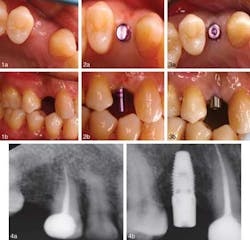Less invasive approach to dental implants allows heart patients to continue anticoagulation therapy
June 18, 2013
3 min read
Journal of Oral Implantology — Dental implant surgery procedures can conflict with the medication needs of heart patients. A less invasive approach to dental implants offers heart patients a better surgical and postsurgical experience, and allows patients to undergo the procedure without interruption of long-term anticoagulant medication. The Journal of Oral Implantology presents two cases in which a flapless surgical technique was used rather than conventional implant techniques. In the flapless technique, implants are drilled directly through the soft tissue into the bone. This study assessed the potential of the modified procedure to reduce bleeding, surgery time, postoperative pain, and soft tissue inflammation.ALSO FROM THE JOURNAL OF ORAL IMPLANTOLOGY |Fluoride treatment of synthetic biomaterial assists dental bone regeneration For patients with prosthetic heart valves, deep vein thrombosis, and other heart conditions, lifelong oral anticoagulant therapy is often prescribed. Warfarin is a commonly prescribed anticoagulant that reduces the risk of thromboembolism. Whether warfarin should be discontinued before dental procedures has been a subject of debate — is the risk of thromboembolism when an anticoagulant is withdrawn a greater threat than the risk of bleeding if it is continued?ALSO FROM THE JOURNAL OF ORAL IMPLANTOLOGY |Stronger bone for oral surgery created by introducing microcracks in the jawbone In this study, the minimally invasive flapless implant technique was used for two heart patients — a 45-year-old woman and a 58-year-old man. Both patients continued their warfarin therapy without interruption. After implant surgery, the patients were monitored for 30 minutes, and subsequent examinations took place one week, five weeks, and six months after the operation. Both patients showed good healing, minimal inflammation, and no abnormalities. No signs of bleeding were present in their follow-up exams.
CASE 1Patient 1.Figure 1. Occlusal and lateral view before the procedure. Figure 2. Occlusal and lateral view of the direction indicator placed during the surgery showing minimal bleeding. Figure 3. (a) Occlusal view of the healing abutment in place immediately after implant insertion. (b). Lateral view of the direction indicator placed during the surgery. Figure 4. Digital periapical radiographic view before and after implant placement.
CASE 2
Patient 2.Figure 5. Patient 1. Occlusal view prior to the procedure. Figure 6. Occlusal view of the healing abutment in place one week after implant insertion. Figure 7. Occlusal and lateral postoperative view of the prosthesis in place. Figure 8. Digital periapical radiograph view before implant placement one week after implant insertion with healing abutment in place. The authors of this study propose designating this technique the “WarLess procedure” — incorporating “warfarin” and “flapless.” This preliminary study shows that flapless dental implant surgery can be safe and effective for patients without interruption of anticoagulant medication. Larger clinical trials are needed to confirm the safety of the technique on a broader scale. Full text of the article, “Flapless Dental Implant Surgery for Patients on Oral Anticoagulants — The ‘WarLess Procedure’: A Report of 2 Cases,” Journal of Oral Implantology, Vol. 39, Special Issue, 2013, is available here.About Journal of Oral Implantology The Journal of Oral Implantology is the official publication of the American Academy of Implant Dentistry and of the American Academy of Implant Prosthodontics. It is dedicated to providing valuable information to general dentists, oral surgeons, prosthodontists, periodontists, scientists, clinicians, laboratory owners and technicians, manufacturers, and educators. The JOI distinguishes itself as the first and oldest journal in the world devoted exclusively to implant dentistry. For more information about the journal or society, please visit their website.
Patient 2.Figure 5. Patient 1. Occlusal view prior to the procedure. Figure 6. Occlusal view of the healing abutment in place one week after implant insertion. Figure 7. Occlusal and lateral postoperative view of the prosthesis in place. Figure 8. Digital periapical radiograph view before implant placement one week after implant insertion with healing abutment in place. The authors of this study propose designating this technique the “WarLess procedure” — incorporating “warfarin” and “flapless.” This preliminary study shows that flapless dental implant surgery can be safe and effective for patients without interruption of anticoagulant medication. Larger clinical trials are needed to confirm the safety of the technique on a broader scale. Full text of the article, “Flapless Dental Implant Surgery for Patients on Oral Anticoagulants — The ‘WarLess Procedure’: A Report of 2 Cases,” Journal of Oral Implantology, Vol. 39, Special Issue, 2013, is available here.About Journal of Oral Implantology The Journal of Oral Implantology is the official publication of the American Academy of Implant Dentistry and of the American Academy of Implant Prosthodontics. It is dedicated to providing valuable information to general dentists, oral surgeons, prosthodontists, periodontists, scientists, clinicians, laboratory owners and technicians, manufacturers, and educators. The JOI distinguishes itself as the first and oldest journal in the world devoted exclusively to implant dentistry. For more information about the journal or society, please visit their website.
About the Author
Sign up for our eNewsletters
Get the latest news and updates



